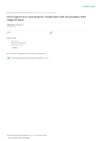Please use this identifier to cite or link to this item:
https://accedacris.ulpgc.es/handle/10553/69960
| DC Field | Value | Language |
|---|---|---|
| dc.contributor.author | Vizcardo, M. | en_US |
| dc.contributor.author | Ravelo García, Antonio Gabriel | en_US |
| dc.date.accessioned | 2020-02-05T12:51:34Z | - |
| dc.date.accessioned | 2020-06-16T10:56:38Z | - |
| dc.date.available | 2020-02-05T12:51:34Z | - |
| dc.date.available | 2020-06-16T10:56:38Z | - |
| dc.date.issued | 2018 | en_US |
| dc.identifier.isbn | 9781728109589 | en_US |
| dc.identifier.issn | 2325-8861 | en_US |
| dc.identifier.other | Scopus | - |
| dc.identifier.uri | https://accedacris.ulpgc.es/handle/10553/69960 | - |
| dc.description.abstract | According to the World Health Organization, the number of people infected with Trypanosoma Cruzi is estimated between 6 and 7 million, the causative agent of Chagas disease, and in 550000 people exposed to the risk of affectation. The approximate entropy was used to quantify the regularity of the tachograms of patients with Chagas disease. The study population consisted of three groups of volunteers: 92 controls (C), 102 patients with positive serology without cardiac involvement diagnosed by conventional non-invasive methods (CH1) and 107 patients with positive serology and mild to moderate incipient heart failure (CH2). We analyzed RR segments of 5 minutes, 288 segments, corresponding to 24 hours per patient. We found significant differences between the Control and CH2 groups, which is used to stratify risk in the CH1 group. | en_US |
| dc.language | eng | en_US |
| dc.relation.ispartof | Computing in Cardiology | en_US |
| dc.source | Computing in Cardiology [ISSN 2325-8861], v. 2018-September | en_US |
| dc.subject | 3202 Epidemologia | en_US |
| dc.subject.other | Heart-Rate-Variability | en_US |
| dc.subject.other | Time-Series | en_US |
| dc.subject.other | System | en_US |
| dc.title | Use of approximation entropy for stratification of risk in patients with chagas disease | en_US |
| dc.type | info:eu-repo/semantics/conferenceObject | en_US |
| dc.type | ConferenceObject | en_US |
| dc.relation.conference | 45th Computing in Cardiology Conference, CinC 2018 | en_US |
| dc.identifier.doi | 10.22489/CinC.2018.234 | en_US |
| dc.identifier.scopus | 85068794318 | - |
| dc.identifier.isi | 000482598700209 | - |
| dc.contributor.authorscopusid | 6503955900 | - |
| dc.contributor.authorscopusid | 57199855886 | - |
| dc.relation.volume | 2018-September | en_US |
| dc.investigacion | Ciencias de la Salud | en_US |
| dc.type2 | Actas de congresos | en_US |
| dc.contributor.daisngid | 12330526 | - |
| dc.contributor.daisngid | 16945488 | - |
| dc.description.numberofpages | 4 | en_US |
| dc.utils.revision | Sí | en_US |
| dc.contributor.wosstandard | WOS:Vizcardo, M | - |
| dc.contributor.wosstandard | WOS:Ravelo, A | - |
| dc.date.coverdate | 2018 | en_US |
| dc.identifier.conferenceid | events121165 | - |
| dc.identifier.ulpgc | Sí | es |
| item.grantfulltext | open | - |
| item.fulltext | Con texto completo | - |
| crisitem.event.eventsstartdate | 23-09-2018 | - |
| crisitem.event.eventsenddate | 26-09-2018 | - |
| crisitem.author.dept | GIR IDeTIC: División de Procesado Digital de Señales | - |
| crisitem.author.dept | IU para el Desarrollo Tecnológico y la Innovación | - |
| crisitem.author.dept | Departamento de Señales y Comunicaciones | - |
| crisitem.author.orcid | 0000-0002-8512-965X | - |
| crisitem.author.parentorg | IU para el Desarrollo Tecnológico y la Innovación | - |
| crisitem.author.fullName | Ravelo García, Antonio Gabriel | - |
| Appears in Collections: | Actas de congresos | |
SCOPUSTM
Citations
5
checked on Jun 8, 2025
WEB OF SCIENCETM
Citations
4
checked on Jun 8, 2025
Page view(s)
162
checked on Mar 1, 2025
Download(s)
99
checked on Mar 1, 2025
Google ScholarTM
Check
Altmetric
Share
Export metadata
Items in accedaCRIS are protected by copyright, with all rights reserved, unless otherwise indicated.
